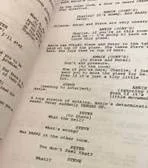
Filmmaking Personal Journey Storytelling Tips/Advice
Conjuring script ideas: A personal reflection on the creative process
by Paul Kahn
Article, 3 pages
Viewed by: 23 Residents and 11 Guests
Conjuring script ideas:
A personal reflection on the creative process
By Paul L. Kahn

STARTING OUT
 Where do ideas for a screenplay come from? There are the usual ways, an adaptation of a book or short story, the life of a famous or infamous person, from a personal life experience, from another film you’ve seen, an idea that just pops into one’s mind, or even from someone you happen to meet for 20 seconds in an elevator. Maybe you’ve seen a movie or TV series and said “Hey, I can write something like that!”
Where do ideas for a screenplay come from? There are the usual ways, an adaptation of a book or short story, the life of a famous or infamous person, from a personal life experience, from another film you’ve seen, an idea that just pops into one’s mind, or even from someone you happen to meet for 20 seconds in an elevator. Maybe you’ve seen a movie or TV series and said “Hey, I can write something like that!”
In this article I’d like to discuss how I conjure up ideas for my screenplays and other topics. I’m in no way suggesting that this could/should/would work for everyone, or anyone. It’s how I go about my ‘creative’ process (such as it is) as well as other considerations I employ in my writing process. Of the 9 screenplays I’ve written, five are original and four are based on real life events, which is my preferred approach to imagining storylines.
A CONCEPT
 To start off, I look for a real-life event such as the flaming crash of a German airship, a Tsunami, the daylight murder of a Communist ex-patriot in London, race riots in the post WWI U.S., or a crucial Revolutionary War battle. It could be something obscure but strikes me as having the potential for a story begging to be told through the eyes of made-up characters. When I come across an event that I think has ‘Wow’ written all over it the first thing I do is think of an opening scene and an ending. Once I have that I create characters and conflicts, and weave it all into the real event, a form of mental storyboarding. It’s easier when I have an idea for Acts 1 and 3, then I just need the middle to connect both ends. I think James Cameron’s classic 1997 masterpiece Titanic is a good example of inserting a fictional story into actual history and creating a captivating story.
To start off, I look for a real-life event such as the flaming crash of a German airship, a Tsunami, the daylight murder of a Communist ex-patriot in London, race riots in the post WWI U.S., or a crucial Revolutionary War battle. It could be something obscure but strikes me as having the potential for a story begging to be told through the eyes of made-up characters. When I come across an event that I think has ‘Wow’ written all over it the first thing I do is think of an opening scene and an ending. Once I have that I create characters and conflicts, and weave it all into the real event, a form of mental storyboarding. It’s easier when I have an idea for Acts 1 and 3, then I just need the middle to connect both ends. I think James Cameron’s classic 1997 masterpiece Titanic is a good example of inserting a fictional story into actual history and creating a captivating story.
My characters, except for one script, are all human. One script is based on the true story of a WWII war dog and his Marine handler who are thrust into combat in the Pacific.
It’s a story of their troubled relationship and the eventual bond that was created between the two warriors. The characters, as well as specific events in the script are fictious, but it’s based on a real war dog and a real Marine, thrown together by Fate, who were both grievously wounded but ultimately survived the horrors of combat in WWII.
GOT AN IDEA, NOW WHAT?
 One of the ‘Commandments’ of screenwriting is “Write About What You Know”. I get that, but you can also write about what you don’t know.
One of the ‘Commandments’ of screenwriting is “Write About What You Know”. I get that, but you can also write about what you don’t know.
Let’s say I have an idea for a movie about a guy who gets stranded on a remote island with his only companion, a volleyball. Who (other than Tom Hanks) knows what that’s like? Short of abandoning myself on an island, I would read books on the subject, such as Moby Dick, Swept Away, Mysterious Island, or Lord of the Flies. Perhaps I’d watch some classic ‘40s movies like Mutiny on the Bounty… things that could give me a” Yes, but what-if?” moment. Sometimes no matter how I try to spin an idea it just doesn’t work. It’s the old square-peg-in-the-round-hole, and it’s time to move on, maybe come back to the pegs later. About four years ago I had an idea for a screenplay, a dramedy, but got only as far as page 22 when I ran out of story, dead end! But I never forgot about it, I thought about it often. So, a while ago I came up with some new thoughts about the plot and went back to revise my pages. I’m up to page 56 now and I think I have a shot at finishing it. Some ideas just never go beyond an idea. As the saying goes, you can’t make a silk purse out of a pig’s ear, but it doesn’t mean that you can’t try.
PREPARATION
 As a writer (with all humility) I write as if I’m part of the story, an uncredited, unseen walk-on without lines or a costume. In preparation for writing my screenplay that takes the protags from 2021 back to 1863 and the Battle of Gettysburg, I read some books and novels about the Civil War (not GWTW!) I also spent two days wandering around the actual Gettysburg battlefield with a guidebook and wireless earphones. This may not be practical for everyone, but I’m fortunate to live a couple of hours’ drive from Gettysburg. When my script got to the battle scenes, in my mind I was there shoulder to shoulder with those gallant boys in Blue and Gray. It’s all make-believe anyway so just go with it and enjoy the trip.
As a writer (with all humility) I write as if I’m part of the story, an uncredited, unseen walk-on without lines or a costume. In preparation for writing my screenplay that takes the protags from 2021 back to 1863 and the Battle of Gettysburg, I read some books and novels about the Civil War (not GWTW!) I also spent two days wandering around the actual Gettysburg battlefield with a guidebook and wireless earphones. This may not be practical for everyone, but I’m fortunate to live a couple of hours’ drive from Gettysburg. When my script got to the battle scenes, in my mind I was there shoulder to shoulder with those gallant boys in Blue and Gray. It’s all make-believe anyway so just go with it and enjoy the trip.
HOW IT ALL STARTED FOR ME
 I started writing as a hobby about 20 years ago. My first script was about terrorists taking over a small Upstate NY town, threatening to blow up the Erie Canal and flood all of Upstate NY, killing millions etc. The idea came to me while I was on an assignment in a town on the Erie Canal. I saw an overpass across the canal (see actual photo above) and thought that if it ever collapsed it would be quite a disaster.
I started writing as a hobby about 20 years ago. My first script was about terrorists taking over a small Upstate NY town, threatening to blow up the Erie Canal and flood all of Upstate NY, killing millions etc. The idea came to me while I was on an assignment in a town on the Erie Canal. I saw an overpass across the canal (see actual photo above) and thought that if it ever collapsed it would be quite a disaster.
The thought became an idea for a movie about a terrorist revenge-attack on the canal. It was my first time out of the chute and all I had as a guide was a book on how to write a screenplay. Predictably, the script was really, really bad at 175 pages! Fast forward 5 or 10 rewrites and three years later. I showed my new 108-page script to my uncle who had once exec produced a “B” movie. He said I had promise (of course he’d say that - I’m his nephew!) and he suggested I take a shot at an idea he had for a movie.
His idea was a film about two life-long friends who became champion rodeo bull riders. Both fell in love with a woman who was also on the rodeo circuit, a classic love triangle.

Initially I thought “Yuck, a love triangle!” I had no interest in either bull riding or love triangles, but I told him I’d give it a shot (I had to say that - he’s my rich uncle!). This brings me back to preparation and research. I started reading about bull riding and the kids (average age of a pro bull rider is 20) who ride the “lightning”. I watched rodeos on TV, went to bull riding events, and even got to interview a bull rider at the rodeo in Prescott AZ. I became immersed in bull riding (still am) but I knew the love triangle was so over-used that whatever the conflict was it needed to be something other than two friends fighting over a woman. I had a “What If” moment and decided the love interest was secondary, a sub-plot. I needed to find out what motivated kids to willingly lash themselves to the back of 2,000 pounds of mean-spirited bone and muscle whose only goal was to get this guy off its back and stomp him into the dirt and sawdust floor! I came to learn that bull riders are incredibly competitive and tenacious, are able to withstand pain, and are totally fearless.
Eventually I learned enough about the sport to tackle the story. I came up with an outline where the primary conflict was between the two friends and their iron-willed, competitive drive that began back in their childhood days.
The spirit of competitiveness that drove them into the world of bull riding was equally strong in their affairs of the heart. After dozens of rewrites and input from a retired movie actor (who has a “With” writing credit) I had a pretty good script. With my uncle’s tireless involvement as exec producer we attached a producer and a musical director with 3 original songs. Uncle ran with it and we got as far as a reading by a rep with William Morris Endeavor Agency.
Ultimately WME passed on it because Clint Eastwood’s son Scott had just starred in a rodeo movie, The Longest Ride, which barely broke even and was a critical failure. After that rodeo movies were seemingly out of favor with Hollywood.
My point is that you can do a deep-dive and learn something about which you didn’t have a clue and turn out an impressive script, market forces notwithstanding. One never knows when things fall back into favor with Hollywood, so I still have hopes for this script. The experience gave me valuable insight into the reality of getting someone to read your spec script, negotiating financing, and getting green-lit.
ACCURACY VS. CREATIVE LICENSE
Another thing that I take seriously is authenticity, aka accuracy. If you’re writing a movie that’s set long ago in a galaxy far, far away then all bets about accuracy are clearly off the table. With the willful suspension of disbelief, anything can be real, whether it’s a light-saber or a mystical force that can raise a rocket ship. But sometimes it’s necessary to sacrifice accuracy for the sake of enhancing drama or making something so obviously out of place that it’s humorous. This is where the creative process extends beyond words in a script, where other creative people have ideas that over-rules what the author has written. I believe a writer should carefully pick and choose his/her ‘battles’ and set aside pride for the greater good of getting the darn movie in the can.
Perhaps it’s because of my background as an investigator when details mattered, or maybe it’s just a case of OCD. I go to distant ends to achieve accuracy in my scripts, even for such obscure things as 1919 phone numbers or the name of a racially segregated Chicago hotel in 1919. All that information is actually on the Internet!
WHAT’S IN A WORD?
 What’s an example of inaccurate composition? Let’s say you’re watching a movie that’s set in the 1700s and the protag is saying things like “wow”, “sure thing”, or “thanks a lot.” People in the 1700s didn’t speak that way and it would jump off the screen as being laughably out of place. In my view I think it’s just lazy writing, it’s distracting, and it takes the viewer (me) out of the moment.
What’s an example of inaccurate composition? Let’s say you’re watching a movie that’s set in the 1700s and the protag is saying things like “wow”, “sure thing”, or “thanks a lot.” People in the 1700s didn’t speak that way and it would jump off the screen as being laughably out of place. In my view I think it’s just lazy writing, it’s distracting, and it takes the viewer (me) out of the moment.
Conversely, when Jabba the Hutt tells Han Solo “You will, therefore, be taken to the Dune Sea and cast into the Pit of Carkoon, the nesting place of the all-powerful Sarlacc.” it makes perfect sense, even though I have no idea what that pit is but it sounds like a really bad thing and I’m glad I’m not going there!
When I write dialogue it’s important that my characters speak with the words and speech-patterns of the period; it gives the script an air of authenticity. It involves a lot of linguistics research, but the Internet is a cornucopia of trivia that can be very helpful if you’re writing a period piece or something with a strong regional theme. A great example of that is the movie Gettysburg, adapted from the Pulitzer Prize-winning novel The Killer Angels by Michael Shaara. The officer’s dialogue and that of ordinary soldiers sounds exactly what I’d expect to hear if I lived in 1863. Another example is a movie I saw where British soldiers had landed in Virginia in the mid-1600’s. They marched off their transports wearing the iconic red uniform jackets, but something about that scene bothered me. I looked it up on the www and learned that the British army didn’t wear red uniforms until the late-1600s. It was a detail, and the film was only slightly inaccurate. Creative license? Possibly the Production Designer decided it was more impactful than having the soldiers marching around in drab, unimpressive uniforms.
In Back to the Future Marty goes into Lou’s Café and orders a Pepsi-Free. It’s funny because from Marty’s POV it’s a perfectly reasonable thing for someone from the 1980s to order, but not to Lou in the 1950s. So authenticity works both ways, depending on one’s POV. If I’m fortunate enough to get produced I’ll have to put my OCD aside and let the creative people who bring scripts to life deal with the color of uniforms. Either way I get a screen credit and a check.
USEFUL RESOURCES
 I’ve found it helpful to read as many produced screenplays as I can find. I’ve read Fatal Attraction probably 30 times. It helped me to learn how to cut action and dialogue and reduce the dreaded over-writing. You can find free script web sites on the Internet and most of them let you down-load scripts. Be sure that the script(s) you read are not drafts but the actual shooting versions. Some free screenplay web sites I use are: Drew’s Script-O-Rama, The Script Savant, Simply Scripts, the WGA West web site, and for members of the International Screenwriters Association (ISA) there’s a library of screenplays on their web site. You can also purchase sturdy, bound copies of scripts in a magazine format from Newmarket Press. It’s the Newmarket Shooting Script Series and you can go to their web site for details.
I’ve found it helpful to read as many produced screenplays as I can find. I’ve read Fatal Attraction probably 30 times. It helped me to learn how to cut action and dialogue and reduce the dreaded over-writing. You can find free script web sites on the Internet and most of them let you down-load scripts. Be sure that the script(s) you read are not drafts but the actual shooting versions. Some free screenplay web sites I use are: Drew’s Script-O-Rama, The Script Savant, Simply Scripts, the WGA West web site, and for members of the International Screenwriters Association (ISA) there’s a library of screenplays on their web site. You can also purchase sturdy, bound copies of scripts in a magazine format from Newmarket Press. It’s the Newmarket Shooting Script Series and you can go to their web site for details.
I used to pick character’s names out of a phone book until they stopped printing phone books, then I turned to the Internet. If you have trouble coming up with original names for characters there’s a free name generator web site called The Story Shack. It has over 1,200 categories of character names and titles for people and things. Check it out at The Story Shack.com.
In summary, this article is meant to (hopefully) inform other aspiring screenwriters in a way that will make writing more meaningful and creative. It is a means for me to share some of the experiences and things I’ve learned about over the years. Some of it you probably know about, maybe all of it, but if there’s some takeaway then I’m glad it’s been useful. I hope that it will might start a constructive conversation/commentary in the Talentville Writer’s Room, so thanks for reading.
--Paul Kahn




